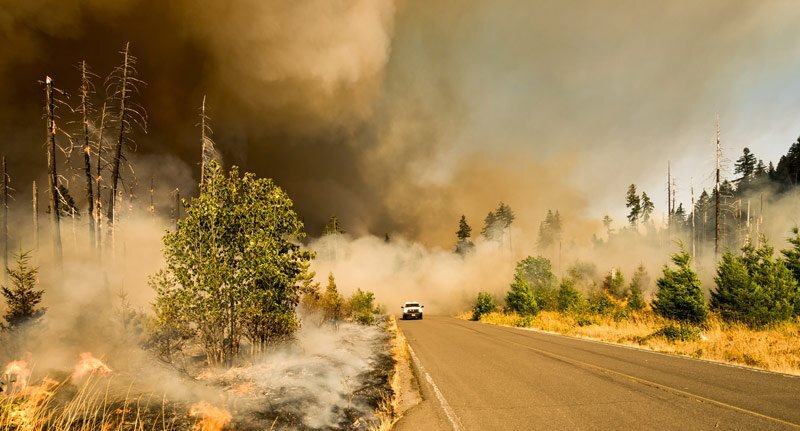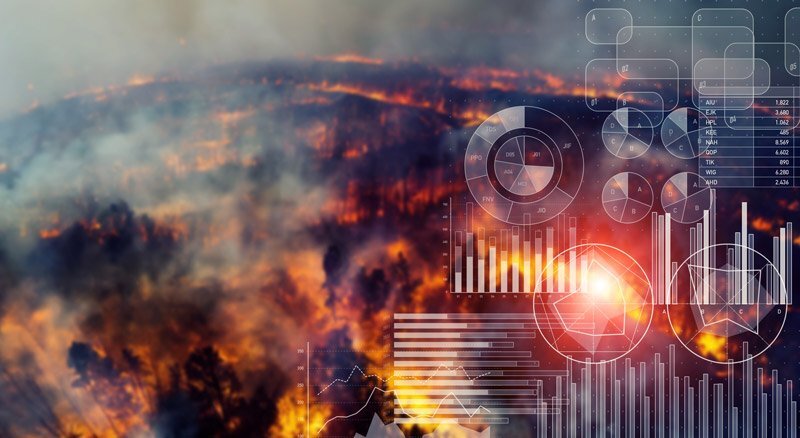Updated June 20, 2023
We originally published this blog post in April, thinking it would be useful and helpful content for the parts of our community tasked with protecting people and assets in areas where wildfires are common. We never once considered ourselves and our susceptibility to fires here in Halifax. On May 27, 2023, just a month after this post was published, we witnessed firsthand the unrelenting fury of this natural disaster as flames engulfed vast stretches of land here at home. The danger loomed for an entire week, as did the worry of friends, family, and the community.
Our experience with wildfires this year, and its continued impact North America-wide, led us to raise awareness of this article once more.
---
Wildfires have long posed a threat to the safety and security of organizations, particularly those located in or near forested areas. These disasters can cause extensive damage to property and infrastructure, disrupt business operations, and endanger the lives of employees and customers.
The challenge for corporate security teams is to address this risk proactively and effectively, given the unpredictable nature of wildfires and the potential for severe impacts. As the frequency and severity of wildfires continue to rise, corporate security teams face increasing pressure to adapt their strategies to mitigate this risk and protect their organizations from harm.
Climate change will likely increase the risk of forest fires, with rising temperatures, changing weather patterns, and prolonged droughts contributing to the likelihood of these disasters. As the effects of global warming continue to worsen, the risk of forest fires is expected to grow even more severe, placing even greater pressure on corporate security teams to address this threat. Failure to do so could result in significant property damage, business disruption, and harm to employees and stakeholders.
To combat the growing threat of wildfires, many corporate security teams are turning to innovative strategies, including the use of Open Source Intelligence (OSINT) techniques. By leveraging publicly available data sources such as social media, news articles, and satellite imagery, these teams can monitor potential wildfire risks in real-time, identify patterns and trends, and take proactive measures to mitigate the risks. OSINT provides security teams with a comprehensive and timely understanding of wildfire conditions, enabling them to make informed decisions and protect their organizations from harm.
The Importance of Mitigating Fire Risk
 Photo by Marcus Kauffman on Unsplash
Photo by Marcus Kauffman on Unsplash
Mitigating forest fire risks is crucial for companies because wildfires have direct and indirect impacts on their operations. Direct impacts include damage to facilities, infrastructure, and equipment, which can result in production delays, revenue loss, and increased costs. Indirect impacts may include supply chain disruptions, workforce shortages, and reputational damage, which can have long-term consequences for the company's financial performance.
Unfortunately, wildfires are particularly challenging to predict and prepare for compared to other natural disasters such as hurricanes or floods. This is because they are often caused by human activities and can spread quickly, making it difficult to contain them. Wildfires can also be influenced by weather conditions such as wind, humidity, and temperature, which can change rapidly and unpredictably.
For this reason, early detection is essential for responding to wildfire risks because it allows companies to take action quickly and prevent or minimize the potential impacts. Early warning systems, such as remote sensing technologies, can detect fires in their early stages and provide real-time information to emergency responders. This information can be used to develop evacuation plans, mobilize resources, and coordinate response efforts.
How to Use OSINT to Mitigate Fire Risk

Using open source intelligence (OSINT) can help companies mitigate the risk of forest fires by providing valuable information and insights that can inform risk management strategies. The following steps can be taken to effectively use OSINT to mitigate forest fire risks:
Identify potential risks:
The first step is to identify the potential risks by conducting a risk assessment. This involves evaluating the likelihood and potential impact of a forest fire on the company's operations, infrastructure, and supply chain.
Monitor relevant social media channels and news sources:
Companies should monitor social media channels and news sources to stay informed about wildfire developments in the region. This can include monitoring local and national news outlets, social media platforms, and government websites for updates and alerts.
Analyze data to identify patterns and trends:
Data analysis can help identify patterns and trends related to wildfire risk, such as areas that are at higher risk of wildfires or seasonal trends in wildfire activity. This can be done using GIS mapping tools, weather data, and historical fire data.
Create actionable plans to mitigate risk:
Based on the information gathered from the risk assessment and data analysis, companies can create actionable plans to mitigate the risk of forest fires. This can include developing evacuation plans, investing in fire prevention measures such as defensible space and fire-resistant materials, and ensuring that critical infrastructure and equipment are protected.
Continuously monitor and adapt plans:
Forest fire risks can change rapidly, so it is important to continuously monitor and adapt risk management plans as needed. This can involve updating evacuation plans, modifying fire prevention measures, and adjusting supply chain strategies in response to wildfire developments.
By following these steps, companies can effectively use OSINT to mitigate the risk of forest fires and protect their operations, assets, and reputation.
Helpful OSINT Tools and Resources
OSINT tools and resources can help corporate security teams mitigate wildfire risk by providing valuable information and insights to inform risk management strategies. Here are a few examples:
Social media monitoring tools: Social media platforms such as Twitter, Facebook, and Instagram can provide valuable information about wildfire activity in real-time. Social media monitoring tools such as Hootsuite, Sprout Social, or Liferaft Navigator can help companies track mentions of keywords and hashtags related to wildfires, monitor public sentiment, and engage with stakeholders.
GIS Mapping Tools
Geographic Information System (GIS) mapping tools can help companies visualize and analyze wildfire data. For example, ArcGIS can be used to map areas at risk of wildfires and identify patterns and trends in wildfire activity.
Data Analysis Software
Data analysis software such as Tableau and Excel can be used to analyze wildfire data and identify patterns and trends. These tools can help companies identify risk factors such as weather conditions, historical fire data, and land use patterns.
News Aggregators
News aggregators such as Google News and Feedly can be used to monitor news articles related to wildfires. These tools can help companies stay informed about wildfire activity in the region and identify potential risks.
Satellite Imagery
Satellite imagery can be used to monitor wildfire activity and identify potential risks. Companies can use tools such as Planet Explorer to access high-resolution satellite imagery of wildfire-affected areas.
Government websites
Government websites such as the National Interagency Fire Center (NIFC) and the National Oceanic and Atmospheric Administration (NOAA) can provide valuable information about wildfire activity, weather conditions, and risk factors.
By using these tools and resources, companies can effectively collect and analyze OSINT data to identify and mitigate the risk of forest fires.
The Bottom Line on Wildfire Preparedness
OSINT can be a powerful tool for organizations looking to protect themselves from the risks posed by wildfires. By using a combination of social media monitoring tools, data analysis software, and other resources, companies can gather valuable insights about wildfire activity and identify potential risks to their operations, infrastructure, and supply chain.
By creating actionable plans to mitigate these risks and continuously monitoring and adapting these plans as needed, organizations can effectively protect themselves from the potential consequences of a wildfire. While wildfires can be unpredictable and difficult to manage, harnessing the power of OSINT can help companies stay informed and prepared to respond to this evolving threat. But by taking a proactive approach to wildfire risk management, companies can help protect their people, their assets, and their reputation in the face of this growing challenge.
